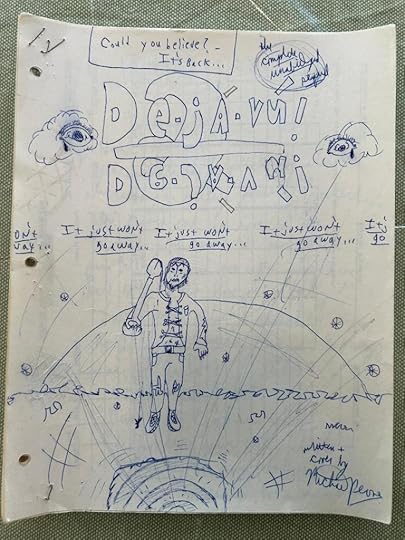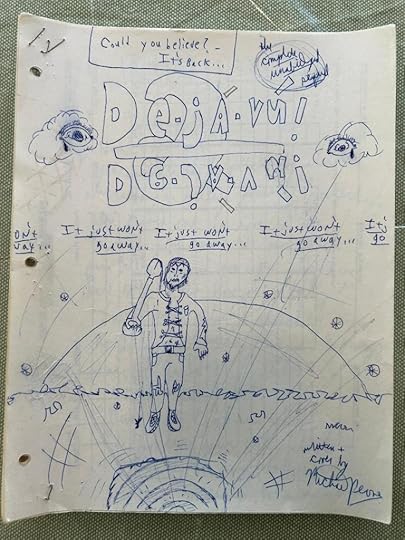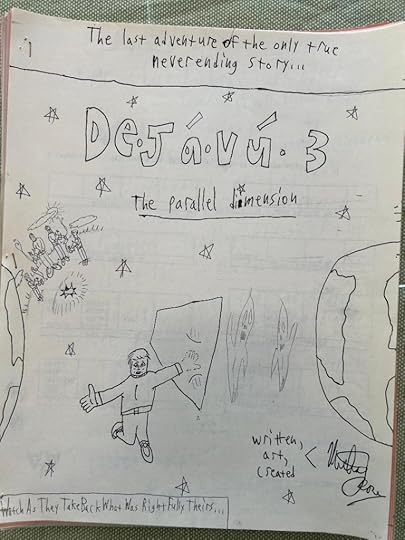My Original Vision for Déjà View (and Its Sequels)
 Worst. Sequel. Ever.
Worst. Sequel. Ever.To follow up on the final question of last week’s FAQ, yes, I wrote two sequels to Déjà View (then titled Déjà Vu), and they were mostly terrible. But let me back up a bit by first explaining the original idea behind the first novel, which was based on a short story I wrote in 1990. This version of Deja View was more of a slasher flick. It was darker and yet somehow sillier. I know that sounds like a paradox, but it’s hard to take the “dark” parts seriously when a 13-year-old is writing them. (How could you know what darkness is when you’re barely a teen, bud? Just wait until high school!) Anyway, the short story was actually more like Final Destination than a Halloween knockoff. (And remember, this was a full decade before the first movie in that never-ending franchise.) You see, the main character, who was not named Bobby but actually named after me, started seeing the “déjà view” visions first (and remember, it was called “déjà vu” in this version), but the visions also started infecting his friends. And when they saw them, they would die in freak accidents, like a car randomly running them over. (I know; I should sue New Line Cinema.)
Eventually, the authorities in town figure the main character, “Mike,” is responsible for these deaths, since they are all connected to him (he is usually the last person they see), and they go after him. And because no one else seems to be seeing the visions except for his friends who helped bury the time capsule, no one believes him, and he goes insane. Hence, the final image in my blog 2 weeks ago where he’s locked in a mental institution wrapped up in a straightjacket. For an added supernatural touch, I threw in a telekinetic ability (I would blame Carrie for the inspiration, but this was years before I saw the movie or read the book), and Mike moves a scalpel across a room with his mind to impale his shoulder blade. End of Déjà Vu 1. There was nothing about the main character not wanting to grow up, or the end of the 1980s, or any of that symbolic end-of-childhood good stuff.
As for Déjà Vu 2, it was more of the same, as most sequels are. This time, though, there was a higher body count (again, as with most sequels). First, here’s the cover:

You’ll notice that I misplaced the accents in the title. Oopsy! (Hey, I was 14.) As for the story, it turns out our main character Mike survived his suicide attempt (obviously—otherwise, there’d be no sequel) with the help of some quick-thinking orderlies and an emergency operation. Mike sobers up, so to speak, and is released, but it isn’t long before he starts seeing those pesky “déjà vu” visions again.
btw, if you want to know how cringe-worthy the dialogue is, at one point, a friend, talking about their mutual deceased friends (from the first book), tells Mike, “Too bad they’re dead now, huh?” Eat your heart out, Aaron Sorkin!
The one twist to this story is that midway through, it jumps forward through time about 11 years, so Mike goes from 14 (the age I was when I wrote it) to 25 (if I did the math right). Having gone crazy and dropped out of school, he roams his town as a bum (I guess I didn’t have much hope for my future at the time) and, after unearthing his time capsule once more, goes on a murderous rampage with the shovel he used to dig it out.
Yet another twist (one too many, I’d argue) was added, when Mike discovers the old time capsule has somehow become a portal to the past, so he uses it to spy on his old friends—who are now, thankfully, alive—burying the original time capsule from the first book, only he has to stop them in order to prevent all these crazy events from happening in the first place. Are you confused yet? I know I am, and I wrote the damn thing.
Anyway, the time portal closes up, and he gets hauled to jail before he can harm his friends. There, he meets a fellow prisoner with the absolute greatest name I have ever invented: Ronda Reef. The name is so insane, I’ll repeat it: Ronda Reef. She helps Mike break out, but he goes crazy again anyway and kills her. (Fun!) So after killing Ronda Reef (yes, I’m saying it a third time), he goes back home, where he gets into a fight with his former self. Here, there are Back to the Future time-travel repercussions, as anything he does to his old self inflicts harm on his present self. So after he knocks his former self’s teeth out, his teeth suddenly pop out. And it gets gorier from there. I’ll spare you the details.
Finally, after “winning” the fight with himself, he destroys the time capsule/portal thing, and it ends up destroying the world and eventually the entire universe. My favorite description of it is the following: “Everyone was moving instantaneously like Max Headroom.” I was a sucker for ‘80s references even back in ’91!
I love the hopeful tagline at the end, though: “THE END…unless this one makes me millions!” Oh, keep dreaming, buddy. That’s what makes you, you.
You would think after ending the last story with the destruction of the entire universe, there couldn’t possibly be another sequel. You’d be wrong. Here comes Déjà Vu 3.

Yes, this is the first Déjà Vu story to have a subtitle: The Parallel Dimension, which, if I’m being honest, isn’t a bad subtitle for a kiddie sci-fi story. Also, the tagline, “The last adventure of the only true never ending story” is at least halfway clever. It was 1992, and I was 15 now, so my writing somewhat improved with this entry. (I’ve been dumping on my old self this entire blog, so spare me a moment of self-congratulatory sentiment. Don’t worry; it won’t last long.) As you can tell from the cover, even though I was older, I was still misplacing the accents in the title. Also, the second tagline, as if the book needed one, “Watch as they take back what was rightfully theirs,” isn’t as inspiring as the first one. (See? I’m back to self-bashing.)
Strangely—or interestingly, if I’m being charitable—the book doesn’t open with any of the previous characters. I guess this makes sense since their entire universe imploded at the end of the last one. Yes, we’re in a “parallel dimension,” as the subtitle promised, and our main character is a stuffy science student named Charles Richard (because one name wasn’t enough) who writes a term paper titled “Repetitious Feelings.” (Eh? Get it? Because of déjà…never mind.)
Flashforward 12 years later, and poor Charles (or Richard, if I’m calling him by his last name) is a geeky, frustrated scientist being haunted by strange dreams of the characters from the former books trying to communicate with him. He tells his wife this proves his theory that before Earth was created, God made a “test copy”—the world that was destroyed at the end of the last book. He creates a “dream machine” to see images of the people from the other world calling out to him. It doesn’t work, so he destroys it, but based on his theory that there are copies of everyone in the world in the other dimension, he comes up with a clever plan to find the people in his dreams. He draws their images on posters and places them around town with the promise of a cash reward if the people show up at his house. Someone does, proving his theory.
Then there’s a scene that genuinely spooked me. Charles notices his neighbor’s Christmas lights blinking on and off across the street. After staring at them a moment, he realizes it’s Morse code, and it’s the people from the other dimension trying to talk to him. So not only do I need to sue New Line Cinema, now it looks like I need to sue the Duffer brothers, creators of Stranger Things. I kid! But man, I did get there first.
The Christmas lights message is an address, so he drives there and discovers a time capsule with the words “Bury me” written in dirt. He does so, and, of course, all hell breaks loose. (This is a Déjà Vu story, after all.) He’s swept up into the alternate universe—oh, sorry, “parallel dimension”—where the characters from the first two books are waiting for him, since they’re the ones who controlled the Christmas lights and somehow planted that other time capsule for him to cross over. Not gonna lie; it doesn’t make a lot of sense. To my credit, though, I was self-aware enough at 15 to break the fourth wall and make inside jokes of how confusing the story is.
Anyhoo, they decide to bury yet another time capsule in the same place as the first one, hoping to be able to cross over to the other world before the first one implodes again. It works, and as soon as they arrive in the new world, the characters from the first books go crazy and try to prevent anyone else from crossing. Charles tries to stop them, and they tie him up and grab a stash of weapons. I admit this comes completely out of the blue, but it looked like I just wanted to wrap up the story, and, as they say, “When things start getting dull, bring out the gun” (or something to that effect). Of course, there’s a big fight at the end, and long story short (too late?), the old characters from the first books get pushed back through the portal to their world, and the portal is sealed off forever. And, apparently, this time I meant it, because there was no Déjà Vu 4.
The book ends strangely (just as it began), though, as it’s centered on the scientific and militaristic (he becomes gung-ho at the end defeating the other characters) triumphs of Charles. He was the main character of this story after all, but still, it would’ve been nice to have one last hurrah with the original boys from the first two books.
Believe it or not, even though it’s the third book in the series, this is probably the best written of the Déjà Vu trilogy. It helps that I was older and my vocabulary was somewhat expanded, although there are some alliterative groaners, like this classic line: “A rouse of rebellious rounds ricocheted off the second realm of repetitious roamers, ramming them into the rafters.” This book also introduced the concept of people from another world trying to cross over but coming in a second too late, thereby becoming trapped in a déjà vu vision—an idea I used for the full-length novel Déjà View.
So that’s it! Now you know the other stories in the Déjà Vu/View sequels. And why I won’t ever write another one.
MTP
P.S.: Next week’s blog: The First (and Possibly Last) Déjà View Goodreads Giveaway!
P.P.S.: Ronda Reef! (I had to do it one more time.)
P.P.P.S.: Déjà View is now available on Amazon and Barnes & Noble:
AmazonBarnes & Noble


